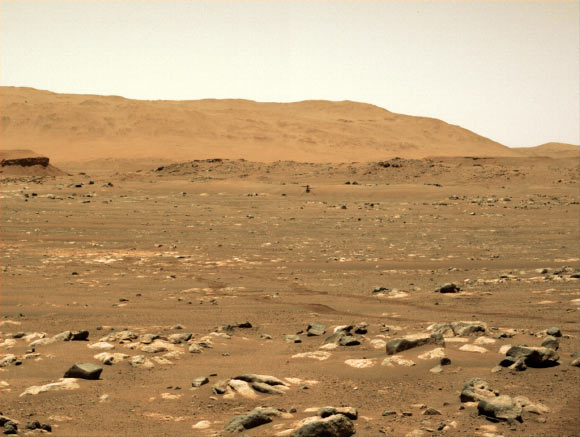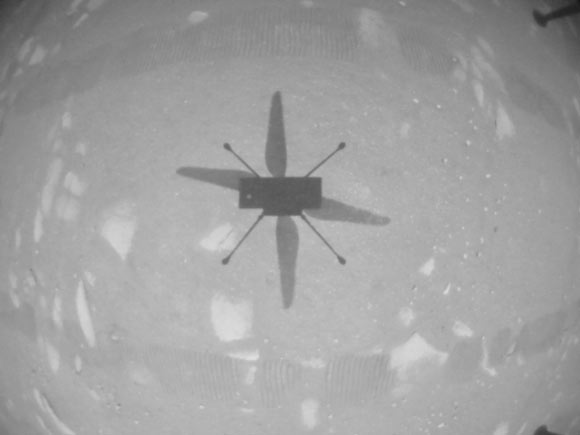On April 19, 2021, NASA’s Ingenuity helicopter made history, hovering above Jezero Crater on Mars, demonstrating that powered, controlled flight on another planet is possible. The Ingenuity team at NASA’s Jet Propulsion Laboratory confirmed the flight succeeded after receiving data from the helicopter via the Perseverance rover at 6:46 a.m. EDT (3:46 a.m. PDT).

NASA’s Perseverance rover acquired this image using its onboard Right Navigation Camera (Navcam). The camera is located high on the rover’s mast and aids in driving. The image was taken on April 19, 2021 at the local mean solar time of 12:33:35. Image credit: NASA / JPL-Caltech.
“Now, 117 years after the Wright brothers succeeded in making the first flight on our planet, NASA’s Ingenuity helicopter has succeeded in performing this amazing feat on another world,” said Dr. Thomas Zurbuchen, associate administrator for science at NASA Headquarters.
“While these two iconic moments in aviation history may be separated by time and 278 million km (173 million miles) of space, they now will forever be linked.”
“As an homage to the two innovative bicycle makers from Dayton, this first of many airfields on other worlds will now be known as Wright Brothers Field, in recognition of the ingenuity and innovation that continue to propel exploration.”
The solar-powered 49-cm- (19.3-inch-) tall Ingenuity helicopter first became airborne at 3:34 a.m. EDT (12:34 a.m. PDT) — 12:33 Local Mean Solar Time — a time the Ingenuity team determined would have optimal energy and flight conditions.
Altimeter data indicate the helicopter climbed to its prescribed maximum altitude of 3 m (10 feet) and maintained a stable hover for 30 seconds.
It then descended, touching back down on the surface of Mars after logging a total of 39.1 seconds of flight.

NASA’s Ingenuity helicopter captured this image as it hovered over the Martian surface on April 19, 2021, during the first instance of powered, controlled flight on another planet. It used its navigation camera, which autonomously tracks the ground during flight. Image credit: NASA / JPL-Caltech.
Ingenuity’s initial flight demonstration was autonomous — piloted by onboard guidance, navigation, and control systems running algorithms developed by the team.
Because data must be sent to and returned from the Red Planet over hundreds of millions of km using orbiting satellites and NASA’s Deep Space Network, Ingenuity cannot be flown with a joystick, and its flight was not observable from Earth in real time.
Parked about 64.3 m (211 feet) away during Ingenuity’s historic first flight, the Perseverance rover not only acted as a communications relay between the helicopter and Earth, but also chronicled the flight operations with its cameras.
“We have been thinking for so long about having our Wright brothers moment on Mars, and here it is,” said Ingenuity project manager MiMi Aung, a researcher at NASA’s Jet Propulsion Laboratory.
“We will take a moment to celebrate our success and then take a cue from Orville and Wilbur regarding what to do next.”
“History shows they got back to work — to learn as much as they could about their new aircraft — and so will we.”
_____
This article is based on text provided by the National Aeronautics and Space Administration.







